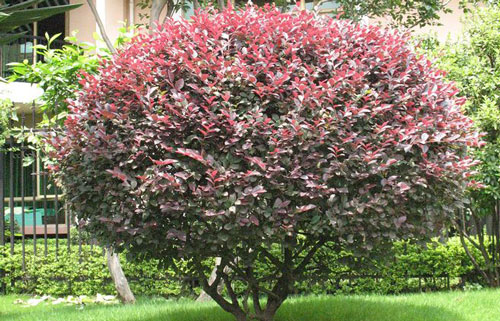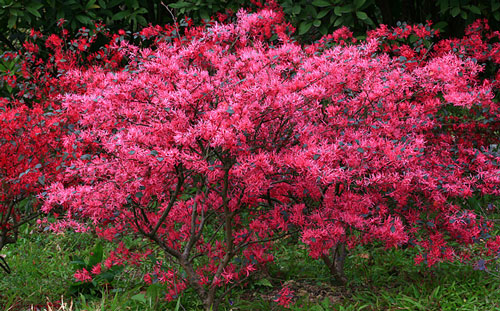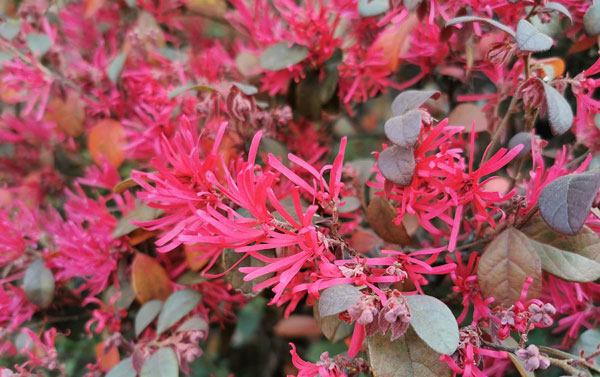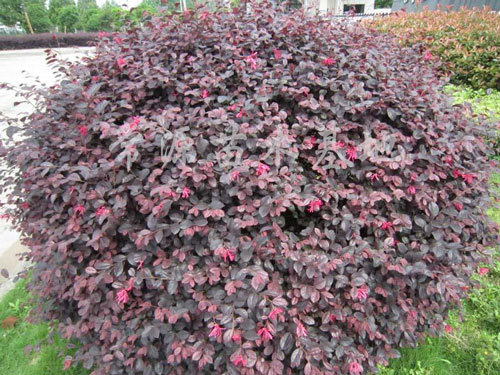Chinese fringe flowers (Loropetalum chinense) Profile
Written by Iris
Nov 13 2021

Chinese fringe flowers (Loropetalum chinense) is native to China and Japan and introduced to the United States in 1880, and these attractive evergreen shrubs are versatile and can be used for a wide range of landscape applications. Looking at the long, thin, petal-like fringed flowers, it's easy to see why Loropetalum is also known as the Chinese fringed flower. Chinese fringe flowers (Loropetalum chinense) have dark green leaves that contrast with their abundant white flowers. Flowers bloom in early spring, creating dreamlike colors that you have to see to believe.

In the garden, this plant often takes the form of a tidy, compact shrub. Although if you have a hundred years or so to wait, Loropetalum plants may reach a rather impressive height of over 30 ft (10 m).
The simple alternately arranged leaves of Loropetalum have serrated margins and are 1 to 2 inches (2.5 to 5 cm) long by 1 inch (2.5 cm) wide. Loropetalum leaves are discolorous and may be green or red-purple.
Generally, the green-leaved varieties have white flowers, while the dark-leaved varieties have pink to red flowers, although there are green-leaved varieties with pink flowers. The new growth of some varieties may start off red and mature to green, creating a plant with multicolored foliage.
Read More:
12 Wonderful Evergreen Shrubs for Your Garden
An ideal moment for planting seedlings is from October to the end of March, but it is essential to avoid frost periods. Wait for the soil to become drier, and dig a hole. It should be three times as wide as the root system of your Chinese fringe flower.
Put the 4 to 6 inches (10 – 15 cm) long seedling in the hole, and add the soil. After abundant watering, place a thick layer of organic mulch on the top.
With Stem Cuttings
For guaranteed results, all you have to do is to use healthy softwood from the start. Look for newly growing stems and take cuttings of about 6 inches (15 cm) long. You must remove the leaves found on the bottom half of the stems to make sure that none are buried in the propagation medium. Moreover, dip the end of the cuttings into a rooting hormone for healthier and faster growth.
Fill a container with a potting mixture made from equal parts of perlite and peat moss. The pot should have drainage holes at the bottom to prevent your cuttings from experiencing soggy conditions. Plant the cuttings in the substrate and cover the pot with a plastic wrap or bag, making sure the material does not touch the Chinese Fringe babies.
Fertilizers are available in many forms: granulated, slow-release, liquid feeds, organic or synthetic. Determine which application method is best for the situation and select a product designed for trees and shrubs, or go with a nutritionally balanced, general-purpose formula such as 10-10-10.
Dead branches should be removed close to the trunk, flush with the bark. When pruning to control a plant's size or shape, cuts should be made just above a leaf bud and at a slight angle. This bud will be where the new growth sprouts.
Many shrubs can be regularly sheared to keep them shaped as a hedge, edging or formal foundation planting.
Chinese fringe flower makes an attractive and eye-catching border plant. In a mixed border, darker leaf forms will contrast beautifully with other plants with green foliage.
These plants can be grown into a stunning small tree if pruned correctly to encourage a single-stemmed form.
Compact and spreading cultivars work well as a ground cover. Loropetalum plants do well as specimen plants in containers and can even be grown as beautiful bonsais.
There are just three white varieties of Chinese fringe flower:
Carolina moonlight– It is 3 to 4 feet (0.9 – 1.2 m) tall, compact shrub with idyllic white flowers blooming from late winter to spring. However, you will enjoy its fabulous blooms from time to time throughout the season.
Snow muffin– This dense, roundish, 1 to 3 feet (30.5 – 90 cm) tall shrub is always full of the dark olive-green foliage and romantic blooms throughout winter and spring.
Emerald snow– With white flowers and green leaves, these 4 feet (1.2 m) tall shrubs are one of the most romantic plants I have ever seen.
Use a larger variety as a dramatic backdrop in a mixed border, along a wall or fence.
For a unique look, train a small-medium sized loropetalum into an espalier along a trellis or fence.
A larger upright specimen can be trained into a small tree by removing the side branches from one or more of the main trunks as it grows.
Mix purple-foliaged varieties, such as Jazz Hands Bold® or Purple Diamond®, with other green-foliaged shrubs or small trees to lend contrast and break up monochromatic color schemes.
Grow a weeping form along the top of a low rock wall or on a slope to complement an Asian-style landscape.
Plant a smaller specimen in a ceramic pot with a similar or complementary color echo and place as a focal point near an entryway.
Plant in a woodland border in combination with regional natives for a natural landscape that supports insect pollinators and wildlife.
Plant a dwarf form such as ‘Daruma’ in a container and group with other containerized shrubs, perennials or annuals for a year-round color display. Site in a key part of the garden such as a patio, deck or balcony.
Plant in a mixed border or along your home's foundation in combination with other shrubs with contrasting foliage colors of gold, chartreuse, blue, or bronze. This will make the colors stand out more against each other. Suggested companions include ‘Goldflame’ spirea, ‘Gold Mop’ cypress, ‘Kaleidoscope’ abelia or ‘Blue Star’ juniper.
Chinese fringe flowers (Loropetalum chinense) PictureChinese fringe flowers (Loropetalum chinense) InfoEcological Habits of Chinese fringe flowers (Loropetalum chinense)Chinese fringe flowers (Loropetalum chinense) Distribution AreaHow to Grow and Care for Chinese fringe flowers (Loropetalum chinense)How to Grow Chinese fringe flowers (Loropetalum chinense)How to Care for Chinese fringe flowers (Loropetalum chinense)Uses of Chinese fringe flowers (Loropetalum chinense)Varieties of Chinese fringe flowers (Loropetalum chinense)Pink-Flowering Forms (Loropetalum Chinense Var. Rubrum)White-Flowering FormsChinese fringe flowers (Loropetalum chinense) Common Pests/DiseasesChinese fringe flowers (Loropetalum chinense) Design TipsChinese fringe flowers (Loropetalum chinense) Companion Plants
Chinese fringe flowers (Loropetalum chinense) Picture

Chinese fringe flowers (Loropetalum chinense) Info
| Botanical Name | Loropetalum chinense |
| Common Name | Chinese fringe flower, loropetalum, strap flower |
| Plant Type | Shrub |
| Mature Size | 15' tall (depending on the variety) |
| Sun Exposure | Sun, part-shade |
| Soil Type | Well-draining |
| Soil pH | 4.5 - 6.5 |
| Bloom Time | Spring |
Ecological Habits of Chinese fringe flowers (Loropetalum chinense)
Loropetalum, also known as Chinese fringe flower or strap flower, is a dense evergreen shrub of the witch hazel family. This plant generally reaches heights of between 6 and 15 feet (1.8 to 5 m) and widths of 8 to 10 feet (2.5 to 3 m).In the garden, this plant often takes the form of a tidy, compact shrub. Although if you have a hundred years or so to wait, Loropetalum plants may reach a rather impressive height of over 30 ft (10 m).
The simple alternately arranged leaves of Loropetalum have serrated margins and are 1 to 2 inches (2.5 to 5 cm) long by 1 inch (2.5 cm) wide. Loropetalum leaves are discolorous and may be green or red-purple.
Generally, the green-leaved varieties have white flowers, while the dark-leaved varieties have pink to red flowers, although there are green-leaved varieties with pink flowers. The new growth of some varieties may start off red and mature to green, creating a plant with multicolored foliage.
Read More:
12 Wonderful Evergreen Shrubs for Your Garden
Chinese fringe flowers (Loropetalum chinense) Distribution Area
The Chinese fringe flower is a member of the witchhazel family and grows in China, Japan and South-East Asia, where the shrub is usually somewhat larger than it is here. Although the plant was bred in Japan, it is more common in China and north-east India.
How to Grow and Care for Chinese fringe flowers (Loropetalum chinense)
How to Grow Chinese fringe flowers (Loropetalum chinense)
- With Seeds
An ideal moment for planting seedlings is from October to the end of March, but it is essential to avoid frost periods. Wait for the soil to become drier, and dig a hole. It should be three times as wide as the root system of your Chinese fringe flower.
Put the 4 to 6 inches (10 – 15 cm) long seedling in the hole, and add the soil. After abundant watering, place a thick layer of organic mulch on the top.
With Stem Cuttings
For guaranteed results, all you have to do is to use healthy softwood from the start. Look for newly growing stems and take cuttings of about 6 inches (15 cm) long. You must remove the leaves found on the bottom half of the stems to make sure that none are buried in the propagation medium. Moreover, dip the end of the cuttings into a rooting hormone for healthier and faster growth.
Fill a container with a potting mixture made from equal parts of perlite and peat moss. The pot should have drainage holes at the bottom to prevent your cuttings from experiencing soggy conditions. Plant the cuttings in the substrate and cover the pot with a plastic wrap or bag, making sure the material does not touch the Chinese Fringe babies.

How to Care for Chinese fringe flowers (Loropetalum chinense)
- Light
- Soil
- Water
- Temperature and Humidity
- Fertilizer
Fertilizers are available in many forms: granulated, slow-release, liquid feeds, organic or synthetic. Determine which application method is best for the situation and select a product designed for trees and shrubs, or go with a nutritionally balanced, general-purpose formula such as 10-10-10.
- Pruning
Dead branches should be removed close to the trunk, flush with the bark. When pruning to control a plant's size or shape, cuts should be made just above a leaf bud and at a slight angle. This bud will be where the new growth sprouts.
Many shrubs can be regularly sheared to keep them shaped as a hedge, edging or formal foundation planting.

Uses of Chinese fringe flowers (Loropetalum chinense)
Loropetalum is a really versatile plant and, with all cultivars available, there are all sorts of possible applications for this species in the garden and elsewhere.Chinese fringe flower makes an attractive and eye-catching border plant. In a mixed border, darker leaf forms will contrast beautifully with other plants with green foliage.
These plants can be grown into a stunning small tree if pruned correctly to encourage a single-stemmed form.
Compact and spreading cultivars work well as a ground cover. Loropetalum plants do well as specimen plants in containers and can even be grown as beautiful bonsais.
Varieties of Chinese fringe flowers (Loropetalum chinense)
Pink-Flowering Forms (Loropetalum Chinense Var. Rubrum)
They may have the red, purple, of maroon foliage with fantastic fuchsia, pink, or reddish-pink flowers. Their height and width vary widely depending on the type of this unique shrub.White-Flowering Forms
Chinese Fringe Flower White-flowering formsThere are just three white varieties of Chinese fringe flower:
Carolina moonlight– It is 3 to 4 feet (0.9 – 1.2 m) tall, compact shrub with idyllic white flowers blooming from late winter to spring. However, you will enjoy its fabulous blooms from time to time throughout the season.
Snow muffin– This dense, roundish, 1 to 3 feet (30.5 – 90 cm) tall shrub is always full of the dark olive-green foliage and romantic blooms throughout winter and spring.
Emerald snow– With white flowers and green leaves, these 4 feet (1.2 m) tall shrubs are one of the most romantic plants I have ever seen.

Chinese fringe flowers (Loropetalum chinense) Common Pests/Diseases
When planted in optimal conditions and properly maintained, loropetalum exhibits few, if any problems. Possible diseases include mildew, anthracnose, root rot, or bacterial gall. There are no significant pest problems, but they can be susceptible to spider mites if kept too dry or in too much sun.Chinese fringe flowers (Loropetalum chinense) Design Tips
There are many ways to incorporate loropetalum into your landscape. Here's how:Use a larger variety as a dramatic backdrop in a mixed border, along a wall or fence.
For a unique look, train a small-medium sized loropetalum into an espalier along a trellis or fence.
A larger upright specimen can be trained into a small tree by removing the side branches from one or more of the main trunks as it grows.
Mix purple-foliaged varieties, such as Jazz Hands Bold® or Purple Diamond®, with other green-foliaged shrubs or small trees to lend contrast and break up monochromatic color schemes.
Grow a weeping form along the top of a low rock wall or on a slope to complement an Asian-style landscape.
Plant a smaller specimen in a ceramic pot with a similar or complementary color echo and place as a focal point near an entryway.
Plant in a woodland border in combination with regional natives for a natural landscape that supports insect pollinators and wildlife.
Plant a dwarf form such as ‘Daruma’ in a container and group with other containerized shrubs, perennials or annuals for a year-round color display. Site in a key part of the garden such as a patio, deck or balcony.
Plant in a mixed border or along your home's foundation in combination with other shrubs with contrasting foliage colors of gold, chartreuse, blue, or bronze. This will make the colors stand out more against each other. Suggested companions include ‘Goldflame’ spirea, ‘Gold Mop’ cypress, ‘Kaleidoscope’ abelia or ‘Blue Star’ juniper.
Chinese fringe flowers (Loropetalum chinense) Companion Plants
Ornamental grasses, heather and dwarf conifer look great with this plant. Chinese fringe flower looks good with many kinds of plants and garden styles from modern to cottage garden. It's a very versatile plant.
Latest Updated
- Benefits of Bugleweed - 7 Science-backed Health Benefits
- Bugleweed Dangers & Side Effects - Is It Poisonous?
- How to Plant Evergreen Trees - What You Should Know
- When to Plant Evergreens - Grow Guide for Evergreen Trees
- 12 Wonderful Evergreen Shrubs for Your Garden
- 12 Popular Evergreen Plants with Pictures for Beginners
- When And How To Prune A Lilac Bush Like a Pro
- How to Grow & Care for Lilac Vine (Hardenbergia Violacea)
- Japanese Lilac Tree (Syringa Reticulata) Care & Propagation Guide
- Shumard Oak Pros and Cons - What to Know
Popular Articles
- Winter maintenance of Antirrhinum Majus
- How to Grow Terminalia Mantaly Tree
- How to Grow and Care for Crossostephium Chinense
- How to grow Antirrhinum Majus in spring
- Peristeria Elata (Dove Orchid) Profile: Info & Care Guide
- Underwatered Snake Plant (Sansevieria Trifasciata) - Signs And How To Fix
- How to Care for Brazilian Jasmine Plant (Mandevilla Sanderi)
- How to Grow & Care for Graptopetalum Purple Delight in Summer
- Rosa Chinensis (China Rose): Plant Growing & Care Tips
- How to Care for Baby Sun Rose (Aptenia Cordifolia)